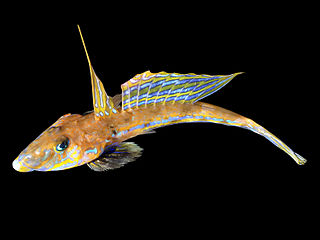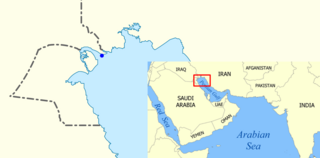
The Percidae are a family of ray-finned fish, part of the order Perciformes, which are found in fresh and brackish waters of the Northern Hemisphere. The majority are Nearctic, but there are also Palearctic species. The family contains more than 200 species in 11 genera. The perches and their relatives are in this family; well-known species include the walleye, sauger, ruffe, and three species of perch. However, small fish known as darters are also a part of this family.

The guitarfish, also referred to as shovelnose rays, are a family, Rhinobatidae, of rays. The guitarfish are known for an elongated body with a flattened head and trunk and small, ray-like wings. The combined range of the various species is tropical, subtropical, and warm temperate waters worldwide.

Dipturus is a large genus of skates native to the Pacific, Atlantic, and Indian Oceans. They were formerly included in Raja. Some species initially moved to Dipturus were later placed in Dentiraja, Spiniraja, and Zearaja.

The thornback ray, or thornback skate, is a species of ray fish in the family Rajidae.

Rhinobatos is a genus of fish in the Rhinobatidae family. Although previously used to encompass all guitarfishes, it was found to be polyphyletic, and recent authorities have transferred many species included in the genus to Acroteriobatus, Glaucostegus, and Pseudobatos.

Callionymus is a genus of dragonets found mostly in the Indian and Pacific oceans with a few species occurring in the Atlantic Ocean.

The Chimaeridae, or short-nosed chimaeras, are a family of cartilaginous fish.

The tub gurnard, also known as the sapphirine gurnard, tube-fish, tubfish or yellow gurnard, is a species of marine ray-finned fish belonging to the family Triglidae, the gurnards and sea robins. It is found in the eastern Atlantic Ocean. It is exploited by commercial fisheries as a food fish.

The common torpedo, also known as ocellate torpedo or eyed electric ray, is a species of electric ray in the family Torpedinidae. It is found in the Mediterranean Sea and the eastern Atlantic Ocean from the Bay of Biscay to Angola, and is a benthic fish typically encountered over soft substrates in fairly shallow, coastal waters. Growing to 60 cm (24 in) long, this species has a nearly circular pectoral fin disc and a short, thick tail with two dorsal fins of nearly equal size and a large caudal fin. It can be identified by the prominent blue spots on its back, which usually number five but may vary from zero to nine, as well as by the small knobs on the rims of its spiracles.

Batoidea is a superorder of cartilaginous fishes, commonly known as rays. They and their close relatives, the sharks, comprise the subclass Elasmobranchii. Rays are the largest group of cartilaginous fishes, with well over 600 species in 26 families. Rays are distinguished by their flattened bodies, enlarged pectoral fins that are fused to the head, and gill slits that are placed on their ventral surfaces.

Chelidonichthys, the smallscaled gurnards, is a genus of marine ray-finned fishes belonging to the family Triglidae, the gurnards and sea robins. These gurnards are found in the Eastern Atlantic, Indian and Western Pacific Oceans.

Symphodus is a genus of wrasses native to the eastern Atlantic Ocean and the Mediterranean Sea.

The black scorpionfish, also known as the European scorpionfish or small-scaled scorpionfish, is a venomous scorpionfish, common in marine subtropical waters. It is widespread in the Eastern Atlantic Ocean from the British Isles to the Azores and Canary Islands, near the coasts of Morocco, in the Mediterranean Sea and the Black Sea.

Agonus is a monospecific genus of ray-finned fish belonging to the subfamily Agoninae in the family Agonidae. Its only species is Agonus cataphractus, commonly known as the hooknose, pogge or armed bullhead. This is a demersal fish found in the coastal waters of the northeastern Atlantic Ocean.

The red gurnard, also known as the East Atlantic red gurnard or soldier, is a benthic species of ray-finned fish belonging to the family Triglidae, the gurnards and sea robins. This fish is found in the eastern Atlantic Ocean, including the Mediterranean Sea and the Black Sea.

The pita skate is a medium-sized skate in the family Rajidae. The holotype and only known specimen was found in the northern Persian Gulf, in Iraqi waters. It was collected at a depth of less than 15 m (49 ft).

Peristedion is a genus of marine ray-finned fish belonging to the family Peristediidae, the armoured gurnards or armored sea robins. These fishes are found in Atlantic and Indo-West Pacific ocean waters.

The rough ray is a Mediterranean ray species of the Rajidae family described by Delaroche in 1809.


















